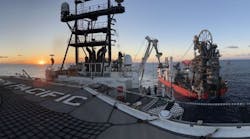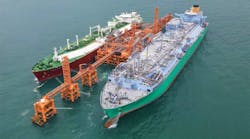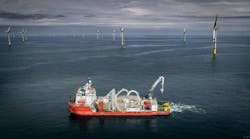Offshore staff
HOUSTON –Dockwise’s new giant transportation vessel Dockwise Vanguard could encourage operators to commission larger spar platforms, the company claimed during a presentation at OTC.
The semisubmersible vessel, currently under construction by Hyundai Heavy Industries in South Korea, will be 275 m (902 ft) long, with a 70-m (229-ft) beam, a hull depth of 15.5 m (51 ft), and with a carrying capacity of 117,000 metric tons dwt (128,970 tons).
Its lifting capacity will be 50% greater than Dockwise’s current largest heavy-lift vesselBlue Marlin, with a 70% larger deck area.
According to Robb Erickson, VP Sales – Heavy Marine Transport, the company decided on the investment because of the market trend towards larger production platforms, spars, TLPs, and FPSOs.
“We needed to address how to transport these structures, which are typically built in the Asia/Pacific region for projects in the Western Hemisphere….We looked at extending theBlue Marlin, but there would have been stress issues.
“We also looked at other types of ships such as tankers, where water comes over the bow, and thought `is that really a problem?’ So we came up with the idea of a transportation vessel without a bow, to free up length. But to make this work, there was a lot of tank testing, simulating different types of cargoes, vessel speeds and routes, such as around the Cape of Good Hope, where the weather tends to be bad.”
The final design called for a deck strength of 20 t/sq m, rising to 45 t/sq m in the center areas, and 90 t/sq m on the side areas.
The vessel will be capable of longitudinal and side skidding operations. Through use of movable casings on the sides of the ship, it will be able to submerge to a water depth of 16 m (52 ft) above the deck, compared with 12 m (39 ft) for theBlue Marlin.
“It’s important for structures with a deeper draft to get them on the deck, and it also helps discharge of structures offshore to deepwater locations,” Erickson said. The re-positionable casings should also give Dockwise more flexibility for loading over the bow or stern, he added.
Dockwise Vanguard will be equipped with 27 MW of propulsion, providing a maximum speed of 14 knots, with an average transit speed of 11-13 knots. This could cut transportation times from the Far East from 120 days for a traditional wet-tow voyage to 50 days, Erickson claimed.
There will be two controllable propellers aft and two retractable azimuthing thrusters under the vessel: “This will help with maintaining heading when the wind tries to push the vessel while carrying a very heavy load,” he added.
Also below deck will be two tunnels, providing a safe escape route for the crew in an emergency. A further safety feature is a fire wall separating the engine rooms from other areas.
“Spar sizes are currently limited by the size of our transportation ships,” Erickson explained. “But the industry would also like to have whole FPSOs built in the Far East, then brought to the Gulf of Mexico, Brazil, or the North Sea in one go, rather than, say, having the topsides built on the Gulf coast, and the attendant integration problems with the hull.”
Aside from transportation, Dockwise will offer the vessel for offshore dry-docking.
“If an FPSO working off Brazil needs work done on a turret, for example, currently that can mean taking the vessel off-station and transferring it to a shipyard in the Mediterranean,” said Erickson. “We can positionDockwise Vanguard alongside the FPSO, submerge underneath it and then lift the vessel up. By installing cribbage underneath the vessel, maintenance crews could perform the work to be performed on site, which would be a big money-saver.”
5/18/2012




